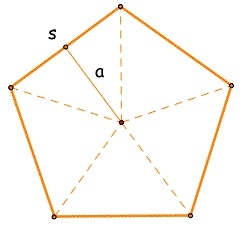Proof for area of any regular polygon

This note is a follow up for my circle area proof here
In this note I will prove that the area of any regular polygon can be written as where a is the anothem and p is the perimeter. I will try my best to make this understandable but it is much easier to understand this proof through video.
In the picture above, we see that all regular polygons can be divided into congruent triangles. The area of a triangle is of course bh/2. However, the triangle's height is equal to the apothem of the original polygon. Thus we have a(b/2).
Now, if we look at all the bases of the triangles, they add up to the perimeter of the original polygon. So the total area of the original polygon is the total area of all the triangles which is where n is the number of sides.
Finally, since bn= the perimeter of the polygon, we arrive at the conclusion that is the area of the original polygon.
Thank you for the challenge @JubayerNirjhor: In my next note, I will prove that the area of any regular polygon can be represented as
. Where n is the number of sides and a is the side length. You can find it here
Easy Math Editor
This discussion board is a place to discuss our Daily Challenges and the math and science related to those challenges. Explanations are more than just a solution — they should explain the steps and thinking strategies that you used to obtain the solution. Comments should further the discussion of math and science.
When posting on Brilliant:
*italics*or_italics_**bold**or__bold__paragraph 1
paragraph 2
[example link](https://brilliant.org)> This is a quote# I indented these lines # 4 spaces, and now they show # up as a code block. print "hello world"\(...\)or\[...\]to ensure proper formatting.2 \times 32^{34}a_{i-1}\frac{2}{3}\sqrt{2}\sum_{i=1}^3\sin \theta\boxed{123}Comments
In most circumstances, people don't know the length of the apothem, but the length of a side. So it's useful to have an area formula with side length and number of sides argument.
If n is the number of sides and a is the length of one side, then the formula is 41na2cotnπ. (Prove it)
Log in to reply
I will try. But trig is not my strong suit.
Got it! It was a fun proof to do, took me about 10 mins because I was thinking of it the wrong way (trying to use identities). I'll post the proof in just a sec.
@Trevor Arashiro Can you add this discussion (along with part 2) to the Regular Polygons - Area wiki page? Thanks!